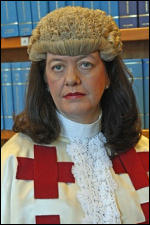Former electrician diagnosed with terminal condition years after asbestos exposure allowed to proceed with damages claim

Lady Wise
A former council electrician who was exposed to asbestos in the 1980s has been granted permission to proceed with an action for damages against the successor council to his previous employer.

About this case:
- Citation:[2021] CSOH 131
- Judgment:
- Court:Court of Session Outer House
- Judge:Lady Wise
It was argued by John Kelman that he was not aware that his condition was sufficiently serious as to justify raising an action of damages until 2019, or alternatively that the court should exercise its discretion under section 17 of the Prescription and Limitation (Scotland) Act 1973. The action was defended by Moray Council, who employed the defender between 1980 and 1984.
The case was heard by Lady Wise. Stewart QC appeared for the pursuer and Springham QC for the defenders.
Remained well
In March 1999, the pursuer was diagnosed with pleural plaques, which were attributed to exposure to asbestos during work he had carried out for the defenders’ predecessor council. He was discharged from his local chest clinic in 2001 after no changes were found, and remained well until early 2019, when he attended his GP surgery after starting to suffer from breathlessness. The pursuer was diagnosed with mesothelioma on 8 March 2019.
The evidence of the pursuer was that he was not aware in 1999 that he could have pursued a claim for his diagnosis of pleural plaques, and only became aware that a claim was possible when he was diagnosed with mesothelioma. He further stated that if somebody had said to him in 1999 that his condition could get worse, he would have taken action then.
Counsel for the pursuer submitted that, while it was accepted that more than 3 years had passed since the date the injuries were sustained, the action was still allowable under section 17(2)(b) of the 1973 Act as it was brought within 3 years of his discovery that the injuries were sufficiently serious as to justify such a claim. Alternatively, the court ought to exercise its discretion under section 19A to override the time limit given the terminal nature of the pursuer’s condition.
It was accepted by the defenders that they were not in a position to assert a defence to the claims made, and that if the court accepted the pursuer’s evidence on fault and causation there was a prima facie case against them. While it was suggested that the pursuer’s recollection of events of over 20 years ago was poor, there was no doubt as to his honesty as a witness.
Constructive awareness
In her decision, Lady Wise said of the pursuer’s evidence: “I found Mr Kelman to be a straightforward witness who was very clear about the matters of detail that he could no longer recollect as distinct from the clear message he considered he had received from the doctors at the chest clinic in 1999, 2000 and 2001. He was able to convey what he understood the doctors were telling him at the time and I accept his evidence on that.”
Addressing the submissions on section 17 of the 1973 Act, she explained: “The evidence led at proof clearly illustrated that Mr Kelman did not have actual knowledge that the injuries he had sustained were sufficiently serious to justify bringing an action of damages until he was diagnosed with mesothelioma in early 2019. The essential question is whether he had been put on notice by the physicians of relevant facts, such that it would have been reasonably practicable for him then to make further inquiries.”
Lady Wise continued: “There is nothing in the medical records available to indicate that he was advised of the risk of mesothelioma and lung cancer, other than so obliquely that it meant nothing to him. It was clear from his evidence that nothing said to Mr Kelman raised any concern on his part about his having sufficiently serious injuries of a type that would prompt him to make further inquiry.”
She concluded on this matter: “In the absence of a clear statement from the physicians that he was at risk of developing a life limiting serious consideration in future, Mr Kelman did not have the requisite constructive awareness. My conclusion that the pursuer did not know that his condition was sufficiently serious to justify exploring the raising of proceedings is sufficient to allow his action to proceed.”
Complete ignorance
Examining the section 19A case in the event that her conclusions on section 17 were wrong, Lady Wise added: “This is not a case where the pursuer has delayed in raising proceedings or has been failed by legal advisers. As soon as he was diagnosed with mesothelioma Mr Kelman sought appropriate advice. His previous ignorance of his legal right to claim for an extremely debilitating and life shortening condition is a relevant factor for consideration. His response on discovering that he could pursue a remedy cannot be faulted.”
She concluded: “Mr Kelman conducted his life in complete ignorance of the implications of a diagnosis of pleural plaques. As soon as the link between the mesothelioma from which he now suffers and that asymptomatic condition was pointed out, he took immediate action. He has acted reasonably and appropriately at all times and is not responsible in any meaningful way for the delay in proceedings being raised. I consider that the equities in this particular case lie in favour of allowing the action to proceed.”
Lady Wise therefore pronounced an interlocutor allowing the action to proceed.






